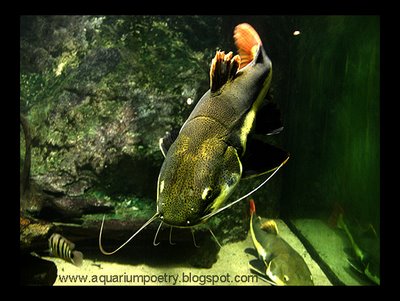Red Tailed Catfish
 Phractocephalus Hemioliopterus
Phractocephalus HemioliopterusJuvenile Red Tails are often offered for sale as small as 1 to 2", and at this size they can be housed in as little as a 20 gallon aquarium. However, this set-up will not last long, as these fish grow very fast given proper feeding. You will soon be needing to upgrade to progressively larger and larger aquariums, ending up with something along the lines of 1500 to 2000 gallons. As you pick your jaw up off the floor, start rubbing your eyes and checking that you read that last line correctly, yes, I did say 1500 to 2000 gallons. This is not a fish for the faint of heart. Their natural habitat is the river basins of the Amazon and Orinoco Rivers, where these rivers are at their deepest and widest. As your Red Tail grows, the amount of decoration in your tank should decrease to give them as much manoeuvrability as possible. These are big fish and they do not turn in a small space. A hiding space should be provided; usually this is accomplished by using large ceramic drainpipe. Red Tails spend a lot of time lurking in their hidey-hole with only their barbels showing. Large rocks and pieces of driftwood are the usual decorations in a Red Tail tank, with many people also adding large fake plants to simulate a river bottom. These need to be very, very well secured. With their sheer bulk, these fish can dislodge almost anything given the chance.
Filtration is very important in a Red Tailed Catfish tank, even more so that with large cichlids. These catfish will regurgitate anything that they cannot digest and they can pollute their tank very quickly. This can lead to disaster, as Red Tails cannot tolerate dirty water. Regurgitation will also include the stomach acids, which will severely affect your water quality. Water changes are required on a regular basis, a minimum of once a week. Care should also be taken in adding anything to the tank that might fit in your fish's mouth, as they could be "sampled" to see if they are edible. As things that are not digestible will be vomited up again, eating odd items will not cause your catfish any major health problems, but these circumstances should be avoided wherever possible.
 Red Tailed Catfish diet in the wild consists of fish, large crustaceans and, surprisingly, fruit. Very small juveniles should be fed twice a day and it is a good idea not to let them get used to live food at an early age. This will prevent problems with refusing other types of food later in life. Bloodworms, earthworms and good quality pellets or tablets designed for carnivorous catfish are a good staple diet when they are young. As larger juveniles, Red Tailed Catfish can be fed once a day with similar types of food. As they grow, their diet can be altered to include small shrimp and crabs, with the occasional treat of shellfish and beef heart. As adults, feeding should be done once or twice a week, with a period of fasting in between meals. At adult size, most Red Tails will ignore foods such as bloodworms and pellets as they are simply not large enough to satisfy their predatory appetites. At this stage, large portions of shrimp, crabs and beef heart are the best source of protein for these monsters. Feeders can be used for adult fish, but they will need to be of a larger size that those offered to large, predatory cichlids. More...
Red Tailed Catfish diet in the wild consists of fish, large crustaceans and, surprisingly, fruit. Very small juveniles should be fed twice a day and it is a good idea not to let them get used to live food at an early age. This will prevent problems with refusing other types of food later in life. Bloodworms, earthworms and good quality pellets or tablets designed for carnivorous catfish are a good staple diet when they are young. As larger juveniles, Red Tailed Catfish can be fed once a day with similar types of food. As they grow, their diet can be altered to include small shrimp and crabs, with the occasional treat of shellfish and beef heart. As adults, feeding should be done once or twice a week, with a period of fasting in between meals. At adult size, most Red Tails will ignore foods such as bloodworms and pellets as they are simply not large enough to satisfy their predatory appetites. At this stage, large portions of shrimp, crabs and beef heart are the best source of protein for these monsters. Feeders can be used for adult fish, but they will need to be of a larger size that those offered to large, predatory cichlids. More...This is a part from the article, beautifully written by Tracey , published at http://www.worldcichlids.com/fishprofiles/redtailcatfish.html
Photos by Dusko Bojic

<< Home